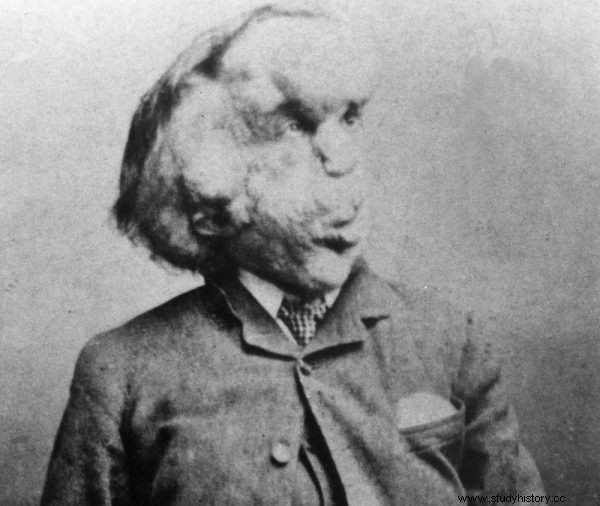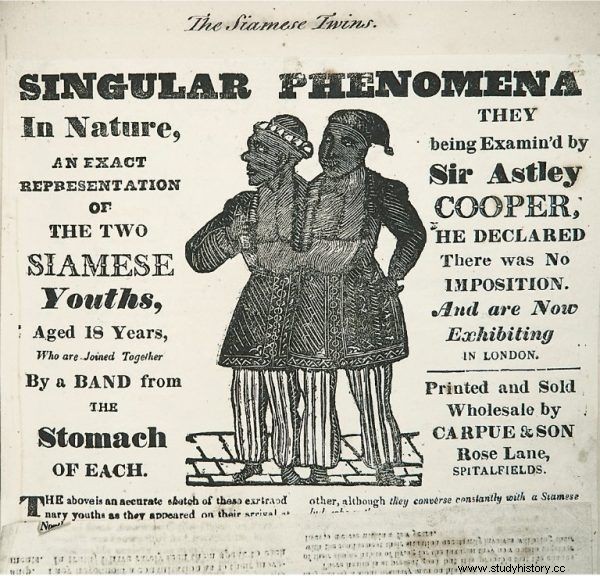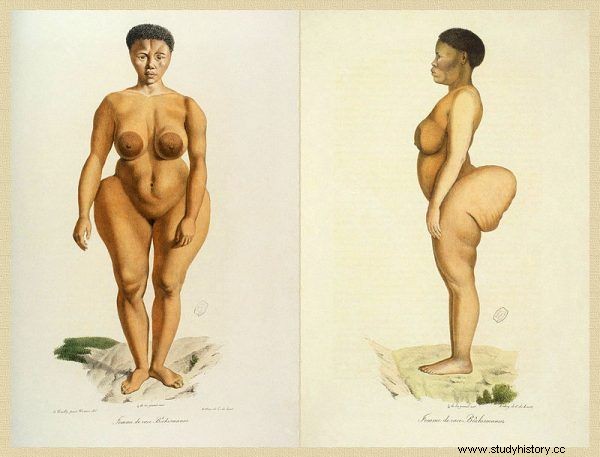The elephant man, Siamese twins or Lady Baboons - in the nineteenth century, the performances of "misfits" attracted crowds. However, while the onlookers were just watching them, the doctors of the time wanted to find out what was the cause of the anomaly at all costs. And they didn't necessarily care about the "patient".
Medicine was still in its infancy when the more agile entrepreneurs decided to make money from human misfortune and present "nature's blind alleys" to the cheerful public. As reported by Yunte Huang in the book "Inseparable. The famous Siamese brothers and their encounter with American history ":
These shows of animals and people - called "monsters", "freaks", lusus naturae , "rarities", "freaks", "eccentrics", "miracles", "wonders", "mistakes of nature", "strange people", "wonders" and "very special people" - they have become fashionable under the end of the 18th century, and their popularity continued throughout the 19th century.
Unusual performances attracted not only the sensation-hungry crowds of ordinary people. In a moment, alone with the "monster", representatives of the then elite - aristocrats, scientists and doctors were also ready to pay dearly. The latter were also interested in the subject for professional reasons.
The specimens are in perfect health
Undoubtedly about the great success of the so-called freak shows among scholars it was largely determined by the fact that they had a solid motivation in the specialist literature to date. As early as 1755, Carl Linnaeus, describing the species of man, separated the "ordinary" Homo sapiens from Homo monstrosus (a monstrous man) and Homo ferus (wild man) .

The "specimen" exhibited in London, for example, was Joseph Merrick, known as the Elephant Man.
A similar distinction was suggested several decades later by Darwin, writing in his book "On the Origin of Species" about Homo monstrosus which was allegedly the product of human interbreeding with other species .
So if serious science has dealt with "weirdos", why not use it for marketing purposes? The more so because the doctors themselves stood in lines to be able to examine the exhibits and issue them with a "certificate of authenticity". And these were more and more priced - because with the popularity of the shows, the viewers' suspicion grew.
However, medics, keenly interested in expanding their knowledge of all kinds of anomalies in the human body, did not treat their eccentric patients subjectively. For them, they were merely "objects", "attractions" to which - as specialists - they should have privileged access.
The famous "original" Siamese brothers - Eng and Chang Bunker, who in 1829, thanks to the British merchant Robert Hunter, came from Siam to America from Siam could not count on anything else. A reporter who was allowed a "pre-premiere" look at the brothers later gave a detailed account of the meeting. His note was enthusiastic and cruel at the same time. As Yunte Huang notes in her book "Inseparable" , the journalist spoke about the twins, "as if he was writing about purebred dogs shown at Westminster" :
They have a good appetite, seem energetic, and run around the deck and quarters of the ship as easily as two normal, healthy boys would do. (…) They will surely be the object of great interest, especially from doctors.
Curiosity (almost) killed the monster
The inquisitiveness of specialists, however, was not limited to conducting an ordinary examination and medical interview with patients. In the end, anomalies exposed to the public were no longer considered an act of God, so they could - and indeed should - be scrutinized closely. What did that mean for Eng and Chang?
John Collins Warren, the first medical authority to deal with them, subjected the fusion of the brothers' bodies to meticulous scrutiny. He touched it and squeezed it between his fingers until the subjects began to show signs of pain, then - to see where the "common feeling" point was - began to prick the body with a pin .
Thus, disregarding the suffering inflicted on the twins, he determined the boundary between their bodies and then ruled:“Their health is good now; however, it is likely that changing their simple lifestyle ... will inevitably bring their lives to an end in the next few years. "
He was not the only specialist who was fascinated by the case of the brothers. Doctor Philip Syng Physik, nicknamed the father of American surgery, simply couldn't wait for Chang and Eng to fall into his hands. It didn't really matter to him whether they were alive or dead - he considered an autopsy to be one of the most effective methods of learning about the human body.

The Siamese brothers Chang and Eng have performed at the "freak" shows all their lives.
British doctors were equally enthusiastic about examining twins, and it took as many as 34 (and they were the best) to issue a "certificate of authenticity" of this particular lusus naturae . Peter Mark Roget, secretary of the Royal Society in London, even attempted galvanic experiments with the brothers . Fortunately, curious specialists refrained from trying to give one of the men mercury (though they had ideas like that).
Subject - not subject - of research
Similar emotions among medics were also aroused by other deformed unfortunates. Unfortunately - they had more to do with unhealthy curiosity than with professional interest. For example, Dr. Frederic Trevers, upon seeing Joseph Carey Merrick, known as the elephant man, reportedly exclaimed: "I have never encountered such a degraded, perverse version of a human being before" . Despite this disgust, he later tried to make a career at Merrick's expense - and partially succeeded.
In turn, Alexander Dunlop decided to earn some money on his charge, Saartjie Baartman. This woman, known as the Hotentock Venus, gained "fame" for the hypertrophy of the hips and buttocks as well as the prominent labia that make up the "hotentock apron". A British surgeon was nearing retirement when he found her in 1810 - and immediately considered her a goldmine.

Alexander Dunlop called Saartjie Baartman "a vein of gold."
Dunlop and Hendrick Ceasar, who owned the woman (bought her with tobacco and alcohol), displayed her to the public in markets and circus arenas in Europe. They forced the dark-skinned Venus to show off their charms while the audience unceremoniously caught her:
One pinched her, another walked around her, a gentleman stabbed her with a cane, a woman using an umbrella was checking that her deformed body was not a costume . Saartjie endured it patiently until someone was really rough on her. (...) In that case, her guardians had to use authority to break her resistance.
Once the chatter grew bored with the woman's voluminous form, Dunlop passed her on to his colleagues. Étienne Geoffroy Saint-Hilaire, director of the Natural History Museum in Paris, gave it a careful examination. He was accompanied by the zoologist Georges Cuvier.
The men stated that Saartjie had "the front of the mouth even larger than that of the orangutan" and that her buttocks looked "like a lapunder monkey during menstruation." And they were furious that the subject of their study refused to fully expose himself , which is perhaps the best testimony to the way in which "monsters" similar to Baartman were treated at that time.
The notable exception in this regard was Dr. Thomas Mütter, a pioneer in plastic surgery. He presented a very innovative and humanitarian (for those times) attitude towards "nature's mistakes". As reported by Cristin O'Keefe Aptowicz:
Teaching [medical students - ed. ed.] that patients visiting the clinic should not be defined by their diseases, injuries or deformities. That they were not riddles to be unraveled, nor cases to be checked off the list. They were human, had names and families, and if the doctors did their job well, they had a future.
For the rest of my life and beyond…
However, there were few such as Dr. Mütter. Most doctors - in the spirit of the age - looked at the "freaks" with unhealthy fascination. Besides, the "freaks of nature" inspired them to experiment not only during their lifetime. After all, it was also possible to earn money by displaying their embalmed bodies. In addition, the corpse did not protest when it was subjected to too invasive examinations and procedures aimed only at satisfying the researcher's curiosity .
In this way, Julia Pastrana, the famous Lady of Baboons, was able to continue her "career" after her death. The Mexican hypertrichosis, suffering from excessive body hair, became the subject of interest of scientists during her lifetime. Surgeon Alexandedr B. Mott, after examining Julia, concluded that she was born from a human relationship with an orangutan. Only Samuel Kneeland recognized her as representative of the Homo sapiens genre .
The woman died of postpartum complications during her European tour, but that didn't put an end to her "performances". A certain professor Sokolov from Moscow State University persuaded Julia's "manager" (and also husband), Theodore Lent, to give him access to the woman's body. He was also interested in a child who died shortly after birth, suffering from the same condition as the mother.

Julia Pastrana aroused the interest of the audience due to her profuse hair.
Using a technique developed by himself, the man embalmed the corpse, stuffed it and posed it so that it looked "as if it were alive". Upon hearing that the procedure was successful, Lent asked for his wife and son, and continued the shows - only with Julia and the baby in glass cases . Anyway, he soon found another mate who was hairy as profusely as Pastran.
Meanwhile, over the years, the popularity of freak shows began to fade. Paradoxically, it was the doctors who played an important role in this, by competing in reports on various anomalies, they stripped them of mystery. It turned out that the "miracles" and "monsters" displayed in circuses and marketplaces are in fact ordinary people, simply suffering from some rare disease. And then the audience, as if by magic, lost interest in the "freaks".
Bibliography:
- Nadja Durbach, Monstrosity, Masculinity, and Medicine:Reexamining 'the Elephant Man', The Spectacle of Deformity:Freak Shows and Modern British Culture , University of California Press 2009.
- Yunte Huang, Inseparable. Famous Siamese brothers and their encounter with American history , 2019 Poznań Publishing House.
- Cristin O'Keefe Aptowicz, Dr. Mutter's Marvels:A True Tale of Intrigue and Innovation at the Dawn of Modern Medicine , Penguin Random House 2014.
- Fiona Yvette Pettit, Freaks in Late Nineteenth-Century British Media and Medicine , University of Exeter 2012.
- Barbora Půtová, Freak shows. Otherness of the human body as a form of public presentation , "L'Anthropologie" 56 (2), pp. 91-102.
- Sadiah Qureshi, Displaying Sara Baartman, the 'Hottentot Venus' , "History of Science" 42 (2), pp. 233-257.
